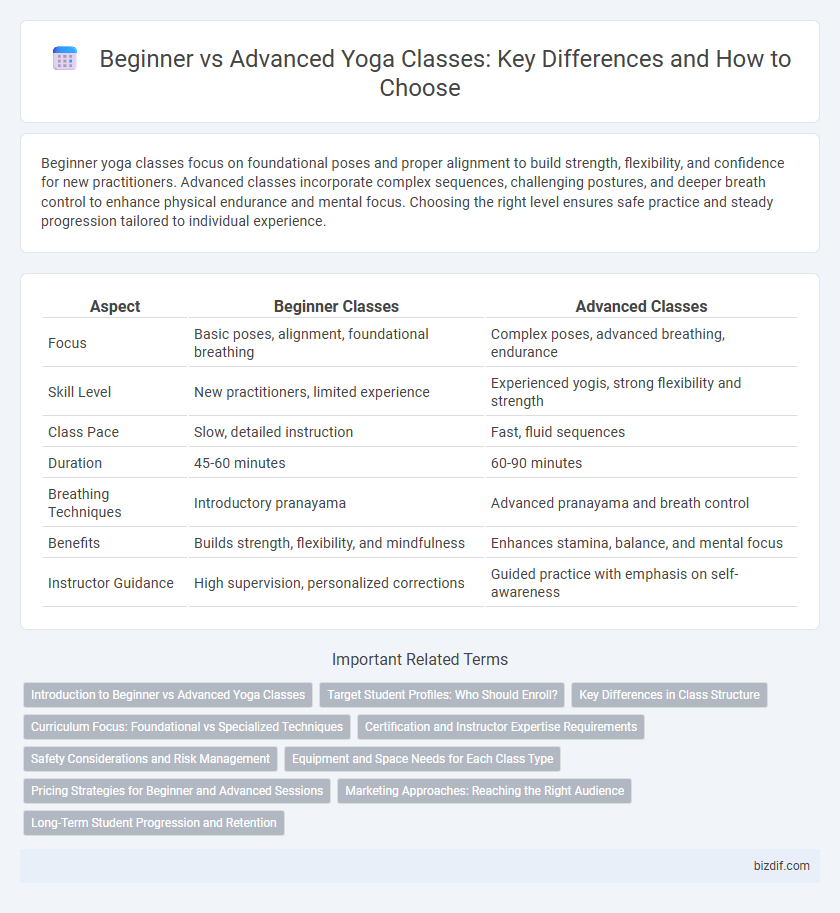Beginner yoga classes focus on foundational poses and proper alignment to build strength, flexibility, and confidence for new practitioners. Advanced classes incorporate complex sequences, challenging postures, and deeper breath control to enhance physical endurance and mental focus. Choosing the right level ensures safe practice and steady progression tailored to individual experience.
Table of Comparison
| Aspect | Beginner Classes | Advanced Classes |
|---|---|---|
| Focus | Basic poses, alignment, foundational breathing | Complex poses, advanced breathing, endurance |
| Skill Level | New practitioners, limited experience | Experienced yogis, strong flexibility and strength |
| Class Pace | Slow, detailed instruction | Fast, fluid sequences |
| Duration | 45-60 minutes | 60-90 minutes |
| Breathing Techniques | Introductory pranayama | Advanced pranayama and breath control |
| Benefits | Builds strength, flexibility, and mindfulness | Enhances stamina, balance, and mental focus |
| Instructor Guidance | High supervision, personalized corrections | Guided practice with emphasis on self-awareness |
Introduction to Beginner vs Advanced Yoga Classes
Beginner yoga classes focus on foundational poses, breathing techniques, and alignment, providing a safe environment for newcomers to build strength and flexibility. Advanced classes emphasize complex postures, increased intensity, and deeper breath control, catering to experienced practitioners seeking to enhance their practice. Understanding the distinctions helps students choose the appropriate class level to progress safely and effectively.
Target Student Profiles: Who Should Enroll?
Beginner yoga classes are designed for individuals new to yoga, seeking foundational instruction on basic poses, breathing techniques, and alignment to build confidence and prevent injury. Advanced classes cater to experienced practitioners aiming to deepen their practice with complex postures, advanced breathing exercises, and greater physical and mental challenges. Target students for beginner classes include those with limited flexibility or prior experience, while advanced classes suit individuals with consistent practice and a solid understanding of yoga principles.
Key Differences in Class Structure
Beginner yoga classes emphasize foundational poses, alignment, and breathing techniques with slower pacing to build stability and confidence. Advanced classes incorporate complex postures, dynamic sequences, and greater emphasis on strength, flexibility, and balance challenges. Class duration and instructor cues also vary, with advanced sessions often requiring longer holds and less verbal guidance.
Curriculum Focus: Foundational vs Specialized Techniques
Beginner yoga classes emphasize foundational techniques such as basic postures, breathing exercises, and alignment principles to build a strong base for safe practice. Advanced classes focus on specialized techniques including complex asanas, advanced pranayama, and deeper meditation practices to enhance strength, flexibility, and mental concentration. The curriculum progression ensures students develop core skills before advancing to more challenging and nuanced yoga sequences.
Certification and Instructor Expertise Requirements
Beginner yoga classes prioritize foundational postures and breathing techniques, typically led by instructors with a 200-hour certification from Yoga Alliance or equivalent. Advanced classes require instructors with deeper expertise, often holding 500-hour certifications or specialized training in advanced anatomy and therapeutic yoga. Certification standards ensure instructor proficiency aligns with class complexity to maximize student safety and progression.
Safety Considerations and Risk Management
Beginner yoga classes prioritize foundational poses and controlled movements to minimize injury risk and build body awareness safely. Advanced classes incorporate more complex postures and deeper stretches, requiring careful supervision and individualized adjustments to prevent strain or injury. Proper instruction, clear communication of physical limits, and use of props are essential strategies in managing risks across all skill levels.
Equipment and Space Needs for Each Class Type
Beginner yoga classes require minimal equipment, often only a yoga mat and basic props like blocks or straps, and can be conducted in smaller, less specialized spaces. Advanced classes demand more space for complex poses and transitions, as well as additional equipment such as bolsters, blankets, and sometimes wall ropes to support challenging postures. Studio design for advanced sessions typically includes more open floor area and reinforced structures to accommodate varied equipment and dynamic movements.
Pricing Strategies for Beginner and Advanced Sessions
Beginner yoga classes typically feature lower pricing to attract new participants and encourage consistent attendance, often offering package deals or introductory rates to boost enrollment. Advanced sessions command higher prices due to specialized instruction, smaller class sizes, and the inclusion of advanced techniques, reflecting the increased value to experienced practitioners. Strategic pricing balances accessibility for beginners while maximizing revenue and perceived quality in advanced offerings, optimizing overall class attendance and profitability.
Marketing Approaches: Reaching the Right Audience
Beginner yoga classes benefit from marketing strategies that emphasize ease, accessibility, and foundational benefits, targeting individuals new to yoga or seeking gentle exercise. Advanced classes require messaging centered on skill development, challenging poses, and deepening practice, appealing to experienced practitioners looking for growth. Utilizing platforms like social media ads with tailored keywords and community engagement helps capture the distinct needs and motivations of each audience segment effectively.
Long-Term Student Progression and Retention
Beginner yoga classes emphasize foundational poses, breath control, and alignment, establishing a solid base for long-term practice and reducing injury risk. Advanced classes build on this foundation by introducing complex sequences, advanced postures, and increased intensity, fostering skill development and deeper body awareness. Structured progression through class levels enhances student retention by maintaining engagement and offering achievable goals that support sustained practice over time.
Beginner classes vs Advanced classes Infographic

 bizdif.com
bizdif.com